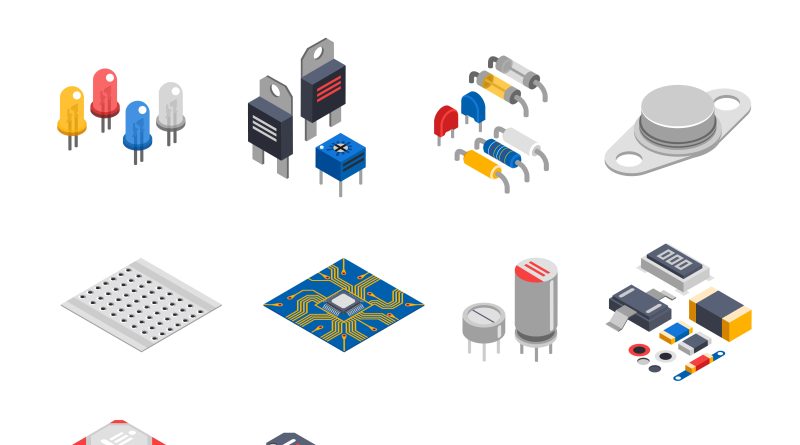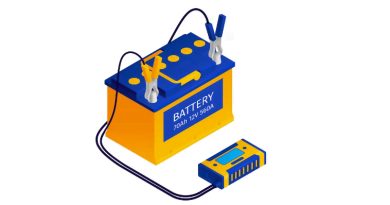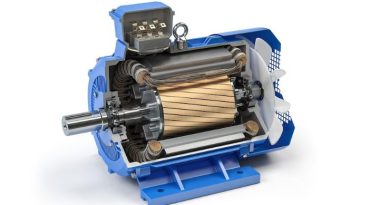Transistors – Different Types of Transistors and Their Applications
Outline:
- Introduction to Transistors
- What is a transistor?
- History and importance
- Bipolar Junction Transistors (BJTs)
- NPN and PNP types
- Principles of operation
- Applications of BJTs
- Amplifiers
- Switches
- Buffer circuits
- Field Effect Transistors (FETs)
- JFETs
- MOSFETs
- Principles of operation
- Applications of FETs
- Amplifiers
- Analog and digital switching
- Oscillators and mixers
- Other Types of Transistors
- HBTs
- HEMTs
- VFETs
- Comparing BJTs vs FETs
- Current flow differences
- Bandwidth, gain, and noise
- Input and output impedance
- Discrete vs Integrated Circuit Transistors
- Discrete construction
- IC transistors in circuits
- Selecting the Right Transistor Type
- Application requirements
- Electrical characteristics
- Cost, availability, and other factors
- Understanding Transistor Specifications
- Maximum ratings
- Terminal configurations
- Switching speeds
- Gain bandwidth product
- Proper Transistor Handling and Storage
- ESD prevention
- Avoid overheating
- Shelf life considerations
- Circuits Using Multiple Transistors
- Multi-stage amplifiers
- Logic gates
- Flip flops and counters
- Maintaining and Troubleshooting Transistor Circuits
- Testing transistors
- Common failure modes
- Repair techniques
- Innovations in Transistor Technology
- New materials
- Nanotechnology
- 3D stacking
- The Future of Transistor Development
- Moore’s Law limits
- New architectures
- Beyond silicon alternatives
The Different Types of Transistors and Their Applications
The development of the transistor in 1947 revolutionized electronics, enabling the incredible computing and communications technologies we use today. But what exactly are transistors, and what are the different types used in modern circuits? This guide will provide an overview of the major categories of transistors and their applications across electrical engineering.

Introduction to Transistors
A transistor is a semiconductor device that amplifies, filters or switches electrical signals and power. Transistors form the fundamental building blocks of all modern electronics.
The most common types are bipolar junction transistors (BJTs) and field effect transistors (FETs). Both utilize semiconductor material properties to control current flow. Millions of microscopic transistors can be fabricated onto a tiny chip when incorporated into integrated circuits.
Understanding the different types of transistors and their application is essential for circuit designers and electrical engineers. Let’s examine the main categories you’ll encounter.
Bipolar Junction Transistors (BJTs)
BJTs contain three differently doped semiconductor regions nearby, creating two p-n junctions in series. The three terminals are labeled emitter (E), base (B), and collector (C). Based on doping, BJTs are categorized into two types:
NPN BJTs
The base is a p-type material sandwiched between the n-type emitter and collector regions. They are the most widely used type of transistor, especially in amplifiers.
PNP BJTs
The base is n-type in PNP transistors, and the emitter/collector is p-type. pnp types are less common than npn, but see some specialized applications.
BJTs control current flow based on the voltage applied across the base-emitter junction. Even a small base current can induce a much larger collector current. This enables amplification.
Applications of BJTs
Thanks to properties like gain, switching speed, and simplicity of fabrication, BJTs have many diverse applications:
Amplifiers
BJTs can amplify small AC signals applied to their base by a significant factor, making them ideal for amplifier circuits. Standard configurations include a common emitter, collector, and base amplifiers.
Switches
BJTs can be used as fast solid-state switches in digital logic circuits, oscillators, function generators, and power control applications.
Buffers
The high input impedance of BJT amplifiers allows them to function as buffers, isolating circuits from loading effects. Emitter follower circuits are commonly used as buffers.
These represent just a sampling of the many uses of BJTs, arguably the most widely utilized transistor type.
Field Effect Transistors (FETs)
Unlike BJTs, FETs use only one kind of doping in their semiconductor channels. Instead, they rely on electric fields to control current flow. Major FET varieties include:
JFETs (Junction FETs)
JFETs have a semiconductor channel with p-n junctions at either end. A reverse-biased p-n junction gate regulates their conductivity.
MOSFETs (Metal-Oxide-Semiconductor FETs)
In MOSFETs, a metal gate electrode on oxide insulation alters channel conductivity to regulate current flow. They are the most widely used type of FET today.
In both types, minimal gate current influences drain current flow through the FET’s channel. This field effect makes FETs effective in amplifying and switching devices.
Applications of FETs
Here are some of the common applications where the advantages of FETs are leveraged:
Amplifiers
FETs are used in amplifiers from RF to audio frequencies. MOSFETs excel in low-noise, high-frequency amplifier circuits.
Analog and Digital Switching
MOSFETs rapidly turn on or off in response to gate voltage variations, ideal for analog or digital switching functions.
Oscillators and Mixers
FETs are extensively used in oscillator circuits for generating signals. Additionally, their nonlinearity enables FETs to function as mixers in radio equipment.
FETs find abundant uses, from voltage regulation to noise reduction across electronics systems.
Other Types of Transistors
While BJTs and FETs account for most transistors in use, other types exist for specialized applications:
HBTs (Heterojunction Bipolar Transistors)
HBTs utilize varying semiconductor materials in their construction to improve high-frequency operation compared to conventional BJTs.
HEMTs (High Electron Mobility Transistors)
HEMTs leverage a junction between semiconductor materials, allowing for very high electron mobility and speed. They are often used in microwave equipment.
VFETs (Vacuum FETs)
Here, the semiconductor channel is replaced by a vacuum. This allows VFETs to operate at much higher temperatures and voltages than conventional FETs.
Comparing BJTs vs. FETs
While both categories of transistors have amplifying and switching capabilities, there are some notable differences:
Current Flow
BJTs use both electron and hole current flows. FETs use electron flow.
Bandwidth, Gain and Noise
FETs typically have higher bandwidths but lower gain than BJTs. FETs also exhibit lower noise, especially at high frequencies.
Input and Output Impedance
FETs have very high input impedance, whereas BJTs have moderate input impedance. However, BJTs have higher output impedance.
Understanding the nuances helps select the optimum transistor for specific applications during circuit design.
Discrete vs. Integrated Circuit Transistors
Transistors are constructed in two primary forms:
Discrete Transistors
Discrete transistors are individually packaged components with exposed leads for insertion into circuit boards. This allows transistors to be easily swapped and tested.
IC Transistors
Microscopic transistors are integrated by the billions onto chips in integrated circuits (ICs). Interconnections between the transistors are internal to the IC package. The small scale enables high complexity and integration density.
Both forms are vital. Discrete transistors provide flexibility, while ICs offer unparalleled sophistication.
Selecting the Right Transistor Type
With the range of characteristics, how do you determine the optimal transistor type for a given application?
Application Requirements
Factor in requirements like voltage, current, power handling, frequency, gain, impedance, switching speed, etc.
Electrical Characteristics
Match transistor specifications and parameters to the requirements. Analyze differences in BJTs vs FETs.
Cost, Availability, and Other Factors
Also, consider big-picture factors like cost, development time, availability, industry preferences, and environmental concerns.
Thorough electrical and contextual analysis ensures you choose the best-fit transistor during the design process.
Understanding Transistor Specifications
Comparing specifications guides transistor selection for a design:
Maximum Ratings
The device can withstand limits for voltage, current, temperature and other parameters.
Terminal Configurations
The labeling and positions of the three terminals – EBC for BJTs, SGD for MOSFETs, etc.
Switching Speed
Important for digital logic. Specified rise, fall, delay, or transition times determine speed.
Gain Bandwidth Product
The product of bandwidth and gain. Indicates high-frequency amplification capabilities.
Always check the datasheet for the exact specifications of candidate transistors for an application.
Proper Transistor Handling and Storage
Transistors can be easily damaged without proper precautions:
ESD Prevention
Use anti-static bags for storage. Ground yourself when handling discrete transistors.
Avoid Overheating
Adhere to power dissipation ratings. Heatsinking is vital for amplifiers.
Shelf Life Considerations
Check datasheets. Some transistors degrade over time if not used. Follow recommended storage conditions.
Careful handling extends transistor lifespan and reliability in circuits.
Circuits Using Multiple Transistors
While single transistors enable many designs, more complex circuits incorporate multiple interconnected transistors:
Multi-stage Amplifiers
Cascading amplifier stages with each transistor magnifies the overall gain exponentially.
Logic Gates
Combining multiple transistors creates integrated circuits implementing fundamental Boolean logic gates like NAND, NOR, XOR, etc.
Flip Flops and Counters
Cross-coupling transistors produce bistable multivibrator flip flops to store state. Interconnected flip-flops create counters.
Understanding transistor combinations unlocks more sophisticated, powerful circuit designs.
Maintaining and Troubleshooting Transistor Circuits
With transistors at the core of nearly all electronics, maintenance and repair skills are invaluable:
Testing Transistors
Use a multimeter to verify transistors in or out of the circuit. Check leakage, resistance, and gain.
Common Failure Modes
Shorts, opens, leakage, loss of gain. Overstress or electrostatic discharge often causes damage.
Repair Techniques
Replace failed discrete transistors. Troubleshoot issues traceable to transistors. For ICs, replace the chip.
Hone your skills at testing circuits under fault conditions and isolating faulty transistors. This maximizes lifespan.
Innovations in Transistor Technology
Despite first being invented in 1947, transistors continue advancing through innovations like:
New Materials
Gallium nitride, graphene, and other exotic materials improve performance over silicon.
Nanotechnology
Nanoscale transistors push density, speed, and power efficiency limits.
3D Stacking
3D integration techniques allow stacking transistors in vertical layers for increased density.
Incredible transistor improvements enabled the computing revolution, with more advancements on the horizon.
The Future of Transistor Development
Even after over 70 years of intensive development, the future looks bright for transistors to become even smaller, faster, and more efficient through:
Moore’s Law Limits Pushed
Though scaling is challenging, silicon transistor density doubles approximately every two years.
New Architectures
3D stacking, new materials, and designs like tunnel FETs overcome the limitations of planar IC transistors.
Beyond Silicon Alternatives
Graphene, carbon nanotubes, and other emerging materials may supplement or replace silicon.
The march of miniaturization continues driving innovation in transistor technology – the key to modern electronics!
Frequently Asked Questions
How do I determine the pinout for an unmarked transistor?
Use a multimeter in diode testing mode to identify the base and emitter pins based on voltage drop polarity. The remaining lead is the collector for BJTs or drains for FETs.
Can I replace a MOSFET with a BJT transistor in a circuit?
Not directly, as their biasing and characteristics differ significantly, however, with proper analysis and component changes, it may be possible to redesign the circuit with the alternate transistor type.
Is gain for a transistor fixed, or does it vary?
Gain varies significantly with an operating point, including collector current, temperature, and frequency. Only DC current gain is fixed by the transistor itself.
What tools can I use to test if a transistor is good or faulty?
A multimeter can check for shorts, opens, and leakage. Curve tracers display detailed characteristic curves and parameters. Oscilloscopes show responses to signals.
How can I calculate the power handling I need from a transistor for an amplifier circuit?
Factor the supply voltage, the maximum current draw of the load, transistor efficiency, and some safety margin. Select a transistor rated for at least this power level.




